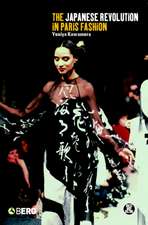Cultural Appropriation in Fashion and Entertainment
Autor Yuniya Kawamura, Jung-Whan Marc de Jongen Limba Engleză Paperback – 13 iul 2022
| Toate formatele și edițiile | Preț | Express |
|---|---|---|
| Paperback (1) | 156.73 lei 3-5 săpt. | +21.50 lei 4-10 zile |
| Bloomsbury Publishing – 13 iul 2022 | 156.73 lei 3-5 săpt. | +21.50 lei 4-10 zile |
| Hardback (1) | 440.59 lei 3-5 săpt. | +48.64 lei 4-10 zile |
| Bloomsbury Publishing – 13 iul 2022 | 440.59 lei 3-5 săpt. | +48.64 lei 4-10 zile |
Preț: 156.73 lei
Nou
Puncte Express: 235
Preț estimativ în valută:
29.99€ • 32.57$ • 25.19£
29.99€ • 32.57$ • 25.19£
Carte disponibilă
Livrare economică 01-15 aprilie
Livrare express 15-21 martie pentru 31.49 lei
Preluare comenzi: 021 569.72.76
Specificații
ISBN-13: 9781350170551
ISBN-10: 1350170550
Pagini: 240
Ilustrații: 40 bw illus
Dimensiuni: 156 x 234 x 15 mm
Greutate: 0.52 kg
Editura: Bloomsbury Publishing
Colecția Bloomsbury Visual Arts
Locul publicării:London, United Kingdom
ISBN-10: 1350170550
Pagini: 240
Ilustrații: 40 bw illus
Dimensiuni: 156 x 234 x 15 mm
Greutate: 0.52 kg
Editura: Bloomsbury Publishing
Colecția Bloomsbury Visual Arts
Locul publicării:London, United Kingdom
Caracteristici
40 images illustrate key examples and each chapter opens with learning objectives and ends with 4-5 examples to promote discussion, including a Pretty Little Things Collection inspired by a traditional Chinese qipao and Yumeyakata, a Japanese retailer, who launched a kimono with matching hijab for Muslim women.
Notă biografică
YUNIYA KAWAMURA is Professor of Sociology at the Fashion Institute of Technology, New York, USA. She is the author of four other Bloomsbury publications: Fashioning Japanese Subcultures (2012), Sneakers (2016), Fashion-ology (2004, 2018), and Doing Research in Fashion and Dress (2011, 2020).Jung-Whan Marc de Jong is Associate Professor of Sociology at Fashion Institute of Technology, New York, USA.
Cuprins
Preface1. Introduction - CultureCulture in Classical Social TheorySchools of Thought: Value-laden and Value-neutral CultureConceptual Tools for Cultural AnalysisOutline of the BookConclusionSuggested Further Reading2. Academic Studies on Cultural AppropriationDefinitions, Processes, and TypesLogos, Mascots, and NicknamesGastronomy and CuisineLiterary WorksAdornmentConclusionSuggested Discussion Examples3. FashionIn Pursuit of Exoticism and Novelty Biological, Cultural, and Sartorial HierarchiesConceptual Typologies The Strength of Weak Virtual TiesConclusionSuggested Discussion ExamplesSuggested Further Reading4. EntertainmentWhat is Sociological about Entertainment?The Commodification of Culture and the OtherConditions of Cultural AppropriationThe Production of Culture in Social Media AgeCultural Hybridization and Cultural Appropriation ConclusionSuggested Discussion Examples5. Ambivalence and Paradox: Derritorialization and Reterritorialization in the Globalized WorldCross-cultural Encounters in a Historical ContextGlobalization and DeterritorializationImmigration and Cultural Globalization through MediascapesCulture as Epistemological Relativism: Coexisting with Harmonious DifferencesAmbivalence in Fashion GlobalizationCultural Authentication Process: Cultural Integration and HybridizationConclusion Suggested Further Reading Conclusion
Recenzii
This is a timely book, given that discussions of what is and is not cultural appropriation are exploding within the academy, museums, fashion design, and social media. Those unfamiliar with the concept will find this to be a fine introduction to the topic, and those well-acquainted with the subject will appreciate the literature review. ... From the beginner to the academic expert (and everyone in between), there is much to learn and appreciate in this thorough recounting of the debates over cultural appropriation.
This is a timely examination of the problems inherent in the way that dominant cultures have taken inspiration from minority groups in ways that have been exploitative. This book makes an important contribution to the wider, political call for an urgent reappraisal of attitudes and inequalities that have had a devastating effect on many communities.
This is a timely examination of the problems inherent in the way that dominant cultures have taken inspiration from minority groups in ways that have been exploitative. This book makes an important contribution to the wider, political call for an urgent reappraisal of attitudes and inequalities that have had a devastating effect on many communities.














